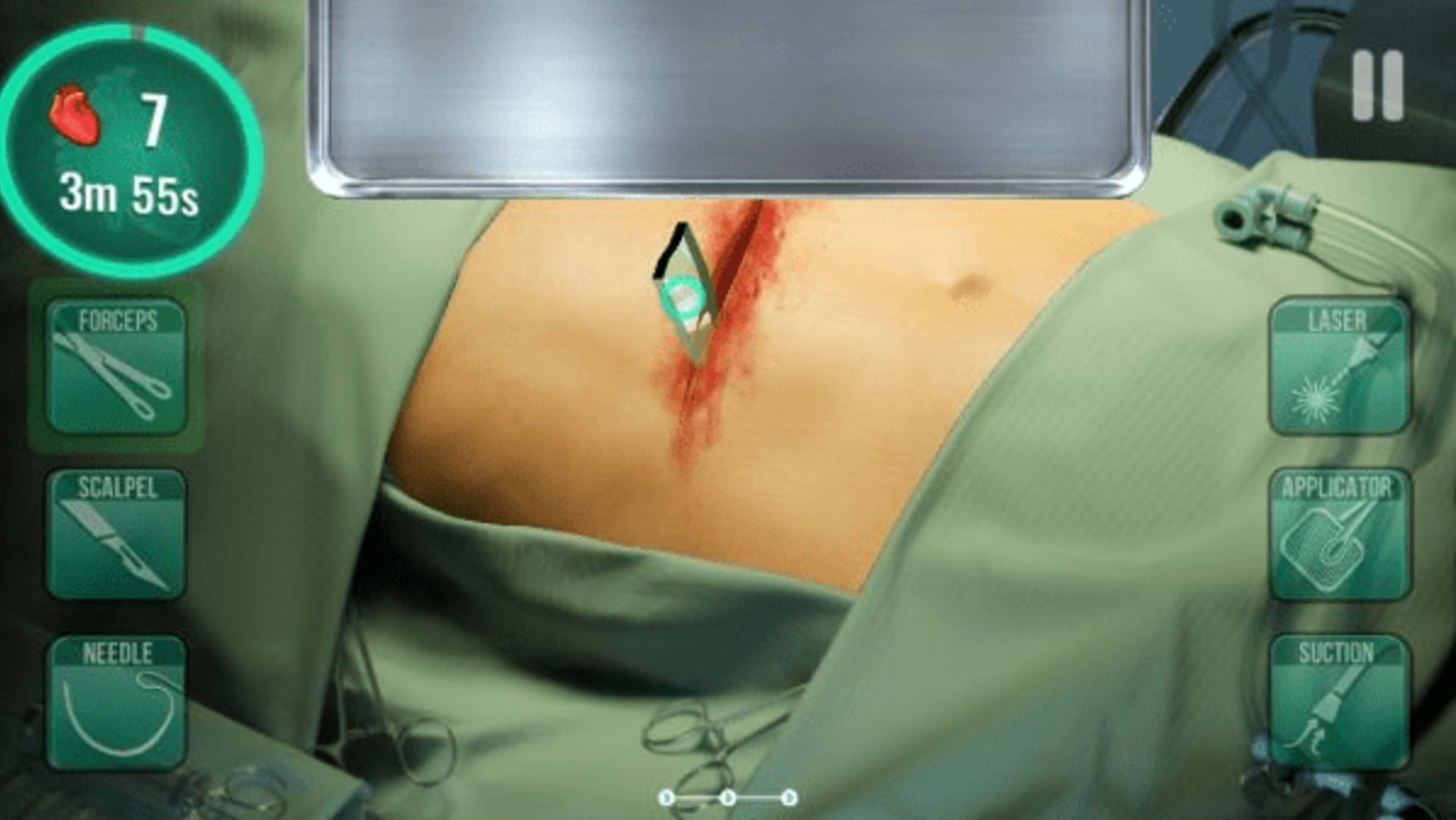No one wants their surgeon to learn on them.
In the past, surgeons practiced on animals and fruit:
“As recently as five to 10 years ago, we bought chicken feet from grocers in Chinatown markets and had our residents practice techniques of tendon repair by suturing chicken flexor tendons," says Dr. Donald Bae, an orthopedic surgeon at Boston Children's Hospital.
He said the tendons in chicken feet aren't easy to get to, but once you find them, they feel a lot like human tendons. Plus, they're super cheap.
But today, 3D printing, realistic mannequins, and virtual reality are transforming how surgeons learn. Last summer, the University of Tennessee College of Medicine in Chattanooga became the final medical school in the U.S. and Canada to stop using live animals to teach surgical skills to students.
Instead of live pigs, UTC surgery students will practice on surgery simulators that mimic the organs and skin of human bodies, complete with bleeding, breathing, and blinking.
Below we'll discuss the benefits of surgery simulators and give you four options for free surgery simulators to get you started.
The benefits of surgery simulators
From trainee surgeons to established surgeons learning a new technique, a surgery simulator is an excellent way to learn in a low-risk environment. Training with simulators reduces accidents.
According to the Institute of Medicine, every year 44,000 to 98,000 people die due primarily to medical mistakes.
Studies have shown that students using simulators perform better and retain more of what they learned than their colleagues who use more traditional methods of medical training. In fact, in one test of medical proficiency, the 20 students who used high-tech simulators vastly outperformed the students who used traditional training.
Another study showed that simulators are effective at helping students learn laparoscopic suturing “through repetitive practice in a non-threatening environment" before they practice on patients.
Compared to older methods, training with a simulator:
Costs less
Is faster
Requires fewer staff members
Requires less staff time
Prevents more medical accidents
Types of surgery simulators
Most surgery simulators fall into one of two categories: mannequins and screen-based simulators:
Mannequins
Mannequins are also called trainers (or Human Patient Simulators by simulation company METI). These can be full-body mannequins or just part of the body, and can include lungs, airways, vascular systems, lumbars, and pelvises.
Mannequins are great because they offer haptic feedback. When you're really holding a scalpel and cutting into something that feels like a body, you learn what that feels like.
Several studies have tried to determine whether haptic feedback really helps a simulator teach laparoscopic suturing. Some showed some difference but others showed no significant difference.
Screen-based simulators or simulations
The other kind of surgery simulator is a screen-based surgery simulator. This can be combined with a mannequin, as one learns laparoscopic suturing, for example.

What the student sees: A screen that resembles what they'd see on a real laparoscopic surgery. What the student feels: Their hands work with real tools on a mannequin. (Source)
Combining visual simulation with force-feedback technology allows a surgeon to experience both kinds of feedback when practicing. TechCrunch points to companies like ImmersiveTouch and Medical Realities as providers of “cutting-edge simulators."
One huge advantage screen-based surgery simulators have over mannequins is that they can automatically, consistently, and objectively measure the surgeon's performance and proficiency gains over time and can track global statistics for medical simulators linked together.
Screen-based simulation has come a long way. A screen-based simulator for lower gastrointestinal endoscopy training was shown to help the surgeons who used it perform better and lower their patient discomfort scores in live colonoscopies.
Another example is virtual-reality-based surgery simulators. VR-related research articles in the Pubmed database have exploded over the last 10 years, from 204 publications in 2004 to 720 publications in 2014. Some studies show VR simulators are as effective as box trainers in teaching laparoscopic suturing.
For companies creating VR training simulators for healthcare professionals check out Next Galaxy and VR HealthNet, zSpace, OramaVR, and SimX.
Free screen-based surgery simulators
1. Touch Surgery
Touch Surgery is a free app available for download in the Google Play and iTunes stores.
After choosing your position (attending surgeon, trainee surgeon, etc.), you choose your specialty: ear, nose, and throat, emergency, cardiology, etc.
I said I was a trainee specializing in emergency surgery.
Then you can choose your lesson. To test, I chose chest tube insertion.
Once I downloaded the lesson, the helpful tutorial walked me through how to use it. For the chest tube insertion, first the app asks you which position you could put the patient in. I guessed at random because I am not a doctor. When I finally guessed right, the app asked me what I should do next. This was the fun part. After a hint, I used my finger to drag the patient's hand to behind his head. You drag and draw and drape and cut with your finger until the surgery is done.

An example of Touch Surgery's animations (Source)
Correct choices and swipes win you points, while incorrect ones cost you.
At the 2017 Consumer Electronics Show (CES), Touch Surgery teased new augmented reality content. Augmented reality is where you look at a screen that's showing real life in real time through a camera lens, but with images and text overlaid on the screen. Think "Pokemon Go." This screen can be a phone, tablet, glasses, or goggles.
For surgeons, augmented reality could mean tips and instruction displayed alongside a patient. Imagine a surgeon picking up the wrong instrument or forgetting a step and an alert flashing on their screen. Or a surgeon getting an objective report at the end of surgery telling them what they could do better next time.
2. Surgery Squad
Surgery Squad is a free browser-based Adobe® Flash® Player game. Like Touch Surgery, you can choose from a variety of surgeries and the game takes you through each stage of surgery.

Surgery Squad screenshot (Source)
But whereas Touch Surgery is a tool that can help you practice, Surgery Squad is more like a game you play to review the steps to a surgery. You don't really make any choices or demonstrate any skill in this game. A voiceover tells you what you're going to do next, then a giant arrow tells you where to click. There are no points.
3. Buckingham Virtual Tympanum

Screenshot from the Buckingham Virtual Tympanum app (Source)
The Buckingham Virtual Tympanum iPhone app had a prestigious introduction, through a report titled “Interactive iPhone/iPad App for Increased Tympanic Membrane Familiarity" by Sheena Samar, MD et al.
It's a free iPhone app that teaches users the anatomical details of the tympanic membrane (TM), an inner-ear structure. First the students review the structure by viewing photos of the TM taken with an operating microscope. Then they answer a series of problem-based questions to familiarize them with the normal structure and also any abnormalities. According to iMedicalApps, the study found that using the app correlated strongly positively with higher test scores.
4. Operate Now
While nowhere near as educational as Touch Surgery, Operate Now is a free game that lets your practice very condensed surgeries while at the same time growing a hospital by taking good care of nurses, patients, and other staff. Gaming Cypher gave it 8.5/10 stars, describing the game's pacing as “nothing less than perfect."

A screenshot from Operate Now (Source)
Touch, Tap, Play writes that “The comic book-style presentation adds a lot of style and character to it, and it's quite exciting to follow along."
One more free surgery-related app to know about
Rapid Recovery is an iPhone app that helps patients undergoing surgery have a better experience and hospitals to improve their processes. If you recommend that patients download the app right after diagnosis they'll have a chance to learn more about their condition. It also offers patients a checklist of the steps they need to take to prepare for surgery. And the steps they should take, and not take, to speed along their recovery.
Along the way, Rapid Recovery reports on activity and outcomes and sends the anonymous data back to the hospital so you can use it to inform your process improvements.
Are you using surgery simulators?
There have never been more ways, or better ways, to learn surgery than there are today. From realistic mannequins to virtual reality, suturing chicken flexor tendons is no longer necessary.
Did I miss any great free surgery simulators in this post? If so, let me know in the comments.